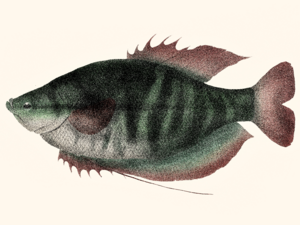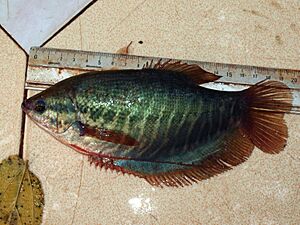Snakeskin gourami facts for kids
Quick facts for kids Snakeskin gourami |
|
|---|---|
 |
|
| A drawing of a snakeskin gourami from an old fish collection | |
| Conservation status | |
| Scientific classification | |
| Synonyms | |
|
The snakeskin gourami (scientific name: Trichopodus pectoralis) is a type of gourami fish that lives naturally in Southeast Asia. It used to be considered the biggest fish in its family. Today, it is still the largest fish in its group (genus) and smaller family group (subfamily).
Contents
What's in a Name?
The name Trichopodus comes from two Ancient Greek words. Thríx means "hair" and poús means "foot." The second part of its name, pectoralis, comes from Latin words. Pectus means "chest" and ālis means "belonging to." This part of the name refers to the fish's large pectoral fins, which are near its chest.
How to Spot a Snakeskin Gourami
The snakeskin gourami has a long, somewhat flat body with a small fin on its back. Its fin underneath, called the anal fin, runs almost the whole length of its body. The two fins on its belly are long and thin, like threads.
This fish is usually olive green on its back. Its sides are greenish-gray with a shiny, silver look. A clear, wiggly black stripe goes from its nose, through its eye, and all the way to the base of its tail. Its belly is white. Sometimes, you might see faint stripes across the back part of its body. The fins are also gray-green. If the water is just right, the fish's eye might even look amber colored!
Male snakeskin gouramis have pointed back fins and their belly fins are orange or red. Males are also thinner than the females, who are not as brightly colored. Young snakeskin gouramis have very clear zig-zag lines from their eye to the start of their tail.
These fish can grow up to 25 centimeters (about 10 inches) long. However, most of them only reach about 15 centimeters (about 6 inches).
Where Do They Live?
Snakeskin gouramis are common in the Mekong River and Chao Phraya River areas. These rivers flow through Thailand, Southern Vietnam, Laos, and Cambodia. People have also brought these fish to other places like the Philippines, Malaysia, Indonesia, Singapore, Papua New Guinea, Sri Lanka, and New Caledonia.
You can find snakeskin gouramis in places like rice paddies, shallow ponds, and swamps. They like calm or still water that has lots of water plants. They also live in flooded forests when the water levels are high. As the floodwaters go down, they move back into the rivers.
What Do They Eat?
Snakeskin gouramis mostly eat water insects and other small living things they find in their home. Like other "labyrinth fish," they can breathe air directly from the surface. They can also get oxygen from the water using their gills.
Snakeskin Gourami and People
Snakeskin gouramis are not as popular as pet fish compared to some other gourami types. However, they are very important as food fish in their native countries. They are caught and raised for food, and also exported for the aquarium trade. In Thailand, the snakeskin gourami is one of the top five most important freshwater fish raised for food.
Their meat is sweet and tasty. People often fry them, grill them, or use them in fish soups like tom yam. In Thailand, you can even buy dried snakeskin gourami. This helps people in areas where fresh fish might not be available.
Many snakeskin gourami farms in Thailand are in places like Bang Bo District and Bang Phli Districts in Samut Prakan Province. Another famous area is Don Kamyan Sub-District in Mueang Suphan Buri District, Suphan Buri Province. But the area with the most farms is Ban Phaeo District, Samut Sakhon Province. All these places are in the central part of Thailand.
Keeping Them as Pets
Trichopodus pectoralis are strong fish and a good choice for beginners in fishkeeping. Even though they can grow quite large, they are peaceful fish. This means they can live happily with other fish in a community tank. They can mix well with fish like barbs, danios, tetras, Corydoras, angelfish, loaches, Loricariids, and other types of gourami.
Snakeskin gouramis usually swim in the middle and bottom parts of the aquarium. They need an aquarium that is at least 91 centimeters (36 inches) long. A tank of at least 151 liters (40 gallons) is recommended for them to grow and be healthy. The water should have a pH level between 5.8 and 8.5. The water hardness should be between 2 and 30 dH. The temperature should be between 22 and 30 degrees Celsius (72–86 degrees Fahrenheit). In a home aquarium, a snakeskin gourami can grow up to 20 centimeters (8 inches).
What to Feed Your Gourami
Snakeskin gouramis are omnivores, which means they eat both plants and animals. They enjoy live foods like Tubifex worms, insects, insect larvae, and crustaceans. They also eat flakes and pellets. You can even feed them chopped spinach and lettuce. They are not picky eaters and will usually accept any food you offer.
Reproduction and Life Cycle
Breeding snakeskin gouramis is not hard. They can start breeding when they reach about 12.5 centimeters (5 inches) long. They are the most productive of all gourami species. A single female can lay as many as 5,000 eggs at one time!
Male snakeskin gouramis are quite calm, even when they are breeding. This is different from some other labyrinth fish. The parent fish also will not eat their babies (called fry). You can feed the fry progressively larger flake food as they grow. Giving them live foods like newly hatched brine shrimp occasionally is a nice treat for them.
When breeding, snakeskin gouramis, like some other labyrinth fish, make sounds. These sounds are described as croaking, growling, or cracking noises. They use these sounds to show that an area is their territory.





